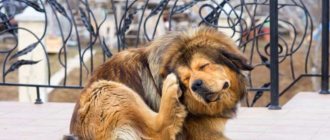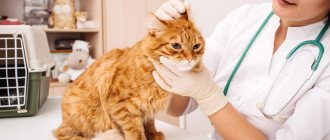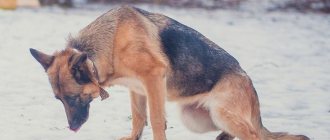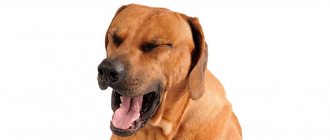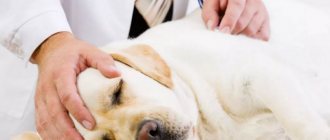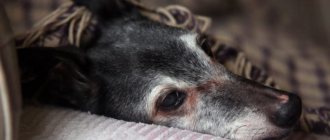The Pug is a very cute, compact breed of dog. For people living in an apartment, this dog is a suitable option. However, this breed has a tendency to various pathologies, which future owners do not think about, although they should. One of these problems is various allergic reactions, which are a manifestation of increased sensitivity of the pet’s body to something.
Types and reasons
Allergy to food (food allergy). To specific chemicals (chemical allergies). On factors of the dog’s environment (environmental allergies, which can be seasonal (for flowering plants) and year-round (for mold, insect bites, and so on).
The main cause of allergic reactions in pugs
– This is
a genetic predisposition. It just so happens that almost all individuals of this breed have manifestations of allergies.
Allergic reactions of a food nature in a dog can occur to food “from your table”: sweets, smoked meats, dairy products, soy. Pugs love chocolate , but it should not be given under any circumstances, because it is a strong allergen. The list of prohibited foods includes citrus fruits, potatoes, beef, and pork.
Previously, chicken white meat (chicken breast) was classified as a dietary type of meat. By 2021, the industrial production of chicken meat has made the latter almost the main allergic meat product.
Diagnostics
During the examination, the doctor visually assesses the signs of otitis in the dog: the condition of the ears, nasopharynx, mouth and eyes. At the same time, asking questions about feeding, vaccinations and existing pathologies.
Be sure to have scrapings, ear discharge and blood tested. Laboratory tests will show the number of bacteria and parasites and determine their adaptability to medications. They will also determine your general condition and the possibility of allergies.
In some cases, radiography is used. This happens if the research is not informative enough. It shows the presence or absence of tumors and polyps in the nasopharynx. It is also possible to conduct a CT or MRI to exclude the possibility of brain inflammation. Some manipulations can be performed under general anesthesia.
Therapy is prescribed only based on test results. A specialist should tell you how to cure otitis media in a dog. Otherwise, the treatment will not bring results and will worsen the situation.
Symptoms and how does it manifest?
Clinical manifestations of allergies can be different. If the following symptoms appear, the owner should suspect an allergy:
The dog has constant severe itching. The appearance of skin flakes (dandruff). The mucous membrane of the eye becomes reddened. Pustular rashes (pimples) appear on the skin of the pet’s armpits, abdomen and chest. Discharge appears from the eyes and nose. The pet becomes lethargic and inactive. Symptoms of colds appear (coughing, sneezing); it begins to smell unpleasant. Digestive disorders of various manifestations appear (vomiting, diarrhea, etc.).
If your pug begins to be bothered by the symptoms described above, you should consult a veterinarian.
Below are photos of allergy symptoms in a pug.
Dangerous insects
During a walk in the summer, insects can easily get into a pug's ears. Is your pug scratching its ears and shaking its head vigorously? Quickly examine the animal. If there is an insect in the ear, it needs to be removed. The insect will not get inside the ear; it will remain in the external auditory canal, from where it can be easily removed. Place the oil in the ear and place the pet on its side; the insect will float to the surface. Now it is easy to remove it with a regular cotton swab. If an insect has crawled deep into the ear, then it is better not to try to pull it out; you will harm the dog by pushing the “alien” deeper. Contact your veterinarian.
Outside and inside
Another unpleasant feature of cute pugs
is a tendency to develop ear allergies.
More often it manifests itself as a rash on the inner surface of the ear, but external and internal purulent otitis media may appear.
Otitis externa is the penetration of infection from the ulcers of an allergic rash into the ear canal.
Internal purulent otitis is a much more serious disease, since the auricle is affected by the infection.
There is an accumulation of pus in the sink. It leads to severe itching. The dog scratches his ear a lot. In addition, this form of otitis is dangerous due to a serious complication - complete irreversible hearing loss.
Preventive measures
In order not to wonder how to treat otitis in a dog, you should carefully monitor your pet.
For prevention purposes, the following measures should be taken:
- regular examination of the dog's ears;
- cleaning when dirty;
- plucking fur from the ear;
- Never rinse the ears of a healthy animal, this increases humidity in the ear;
- in slush and frost, pets with chronic otitis media should wear a hat;
- visit the veterinary office at least 2 times a year for a preventive examination.
We wish your pet a speedy recovery.
How to treat?
To treat food allergies, you should follow a certain diet and take sorbents. If dyspeptic syndrome manifests itself (vomiting, diarrhea), you can feed the food from the Gastrointestinal line (produced by Royal Canin, Purina Pro Plan and others) for 2-3 weeks.
For severe itching, a large number of scratches, ulcers and symptoms of infectious diseases (purulent otitis media, etc.), antibacterial drugs are prescribed. If your pug's eyes are very red, eye drops may be prescribed.
Antihistamines for dogs are used as antiallergic therapy.
Basic anti-allergy medications:
Chloropyramine (suprastin). Tavegil. Diphenhydramine. Zyrtec. Fenistil.
In case of severe itching and local inflammatory processes, the doctor may prescribe the use of ointments with glucocorticosteroids.
First aid medications for ear allergies are:
These medications help relieve pain and itching. Treatment of internal purulent otitis is carried out only with the help of surgery. All dosages of drugs must be selected by a specialist, taking into account the weight and age of the animal, as well as the possible development of a more severe allergy to the drug.
Under no circumstances should you use medications manufactured for humans. Self-medication is dangerous! The process of starting, continuing and ending treatment must be supervised by a veterinarian.
Treatment of ear disease in dogs
Any ear disease in your pet that is diagnosed late or not fully treated can result in unpleasant consequences, including deafness, and even death.
Therefore, it is very important to diagnose the disease at the slightest discomfort in the animal, correctly determine the cause and treat it according to all the rules from beginning to end.
It is very important, having recognized the signs of the disease, not to take any self-medication measures in order to avoid serious consequences - first you need to establish with the help of a veterinarian what exactly happened to your pet, and only then treat it correctly.
At the veterinary clinic you will undergo a bacteriological test (scraping), based on the results of which treatment will be prescribed. You can treat your dog at home, without the help of a veterinarian, the treatment methods are quite simple, the main thing is to follow the doctor’s instructions and not skip procedures. Most often, medications are prescribed that simply need to be instilled (placed) into the animal’s ear several times a day.
Prevention
For food allergies, the main preventative measures are the following:
If a reaction appears to a new type of food, it should be removed from the dog’s diet; Do not give your pet “goodies”: eggs, sweets, chicken, smoked meats, chocolate; Feed your dog only premium dry and wet food; Carefully study the composition of dog food; Natural foods (meat, cereals) that are ideal for feeding include rice cereal, lamb, rabbit, and turkey meat. These products are dietary, since they almost never cause pathological reactions in the dog’s body; You should choose your diet extremely carefully and always be on guard. Allergies do not always manifest themselves from the very first feeding.
Preventive measures for chemical allergies:
Study the chemical composition of care products, medicinal and prophylactic agents; If you are allergic to flea and tick collars, be sure to stop using them immediately; Before vaccination and use of medications, conduct an allergy test; To care for your animal, use only hypoallergenic shampoos and lotions for animals. The use of human shampoos is strictly prohibited, as they are powerful allergens for sensitive pugs.
Prevention of environmental allergies:
Once every 6 months, mandatory deworming (taking medication for worms). The drug should be purchased at a veterinary pharmacy. Before purchasing, you need to know the dog’s body weight, since the dosage of the drug is calculated based on this indicator; During tick season, you should wear a flea and tick collar (unless you have a chemical allergy to the components of the collar) or use drops prescribed by your veterinarian; Flea prevention is similar to tick prevention; Frequent wet cleaning of the premises where the dog lives is also important. It is important to get rid of dust and mold; Particular attention should be paid to your pet's ears. Examination and cleaning of the ears will help in finding mites, as well as purulent-inflammatory processes, which will help in the timely initiation of treatment for the pug and its rapid recovery; When an allergy-causing plant blooms, it is necessary to isolate your pet from the allergen as much as possible.
Treatment
Before starting full treatment, it is necessary to exclude the pug from contact with allergens. This could be food, animal care products, or even a product that the owner uses to wash the pet’s dishes. Limit your walks during the flowering period of various plants. If the allergen can be identified and eliminated, then treatment can begin. If it is not possible to identify the allergen, you must contact a veterinarian and carry out a diagnosis.
Local treatment
The use of topical medications is aimed at eliminating the external manifestations of inflammation, getting rid of itching and redness. Antibacterial agents are used for this. Veterinarians often prescribe complex therapy consisting of several drugs:
- Sanoderm ointment has anti-inflammatory and antibacterial properties;
- Hypoallergenic shampoos Herba Vitae, 8in1 Sensitive Shampoo or Espree Aloe Oat bath Medicated Shampoo are used to eliminate itching and redness and soothe the skin;
- To quickly heal open wounds, use Ranosan, Sanatol or Bioseptin;
In case of allergies in the pug's ears, Suprastin, Tavegil and even Diphenhydramine are prescribed. To effectively use topical medications, you must carefully clean the affected skin before use. Failure to prepare the skin area for procedures may not provide a therapeutic effect.
Read Removing the fifth toe from a puppy and an adult dog: 3 stages
Tablets, solutions and injections
The use of medications for internal use is the main step in the treatment of allergies in pugs. Prescription of drugs should be carried out by a qualified veterinarian. Typically, the treatment regimen for the disease is as follows:
- First of all, they give antihistamines - Suprastin, Tavegil, Diphenhydramine;
- The next step will be treatment of allergy symptoms and its consequences - Cyclosporine, Apoquel;
- Further, the risk of developing secondary infections in open wounds is eliminated. For this purpose, the drugs Sofradex, Otipax, Surolan are used.
- To speed up your pet's recovery, your veterinarian may prescribe immunomodulators, vitamins and minerals.
The duration of treatment depends on the severity of the allergy and the dog’s immunity. It usually takes no more than two weeks to get rid of all symptoms.
Hypoallergenic food
Poor nutrition in a pug is the most common cause of allergies in both the ears and other parts of the body. Dietary adjustment is considered the most effective way to treat it. Even if the symptoms of a food allergy have been eliminated with the help of medications, the disease can only be completely eliminated by eliminating the allergen from the diet.
It is extremely difficult to identify an allergenic food component; for this, a special mono-diet is used:
- Eliminate chicken from the diet, which very often provokes allergies in pugs. You can replace it with rabbit or lamb.
- Only rice can be given with meat; this is the only grain that does not cause allergies in 99% of cases.
- The pug should eat only rice and meat for 2 weeks. Further, it is allowed to introduce one component into the diet every 5 days.
- This way you can identify which foods cause allergies in your pug and which are hypoallergenic. The allergen must be immediately excluded from the menu.
- It is advisable to write down the foods that the owner gives to the dog and describe the pet’s reactions to them. This way you will have a list of safe and unsafe foods.
Read Treatment of allergies in a French bulldog: selection of dry food
Bad dry food is more difficult to identify, but the principle is the same. Replace producers and types of food for 5-7 days and observe the reaction. The problem of allergies in pugs is not isolated; reviews from owners have compiled a list of safe dry food for pugs:
- Care Adult Large Breed lamb with rice;
- Golden Eagle Salmon&Potato Adult;
- Our Mark with lamb and rice;
- Monge (2.5 kg) Specialty Line Hypoallergenic – Salmon and Tuna;
- Golden Eagle Lamb&Rise;
Hypoallergenic foods are now very common and can be bought at any pet store. You should not buy large amounts of food at once; some of it may not be suitable for your pug. Allergies are a very individual phenomenon and can be caused by even the most harmless substances.
How to clean?
To clean your ears, you need to prepare a cotton pad, lotion, powder, or choose special wet wipes.
- In order to soften the wax, you need to drop lotion into your ears and massage them for a minute. Next, the discharge is removed with a dry cotton pad. The most commonly used lotions are 8-in-1, Cliny, Twins, mr. Bruno, Bars and others.
- When using cotton swabs, there is a risk of damaging the eardrum.
- Wet wipes clean and disinfect at the same time, but can cause irritation. If redness or pimples appear, it is recommended to stop using this product.
- A special powder dries the surface of the ear and deodorizes. The most popular powders are 8-in-1, Biogrum. However, the cost of this product is significantly higher than others.
It is optimal to combine bathing the dog and cleaning the ears.
Why and whether it is necessary to glue the ear cloth
The shape of a dog's ears is determined by genetics, but the cartilage is adjusted to meet the breed standard. This is important for participation in exhibitions and breeding, and not for the pet itself. It is often written that the correct “closed” form is healthier, but this is a misconception.
Before gluing the ears, you need to remove excess sebum. This is done with a gauze swab soaked in chlorhexidine or dog grooming liquid. Then you need to wait an hour for the canvas to dry completely, otherwise there will be irritation. The process itself is quite simple:
- the canvas is straightened parallel to the head;
- bend lengthwise exactly in half, outward. That is, the edges are folded towards themselves;
- above the middle, that is, closer to the base, wrap it across.
The canvas should hang forward freely. You cannot squeeze the cartilage too much, as this will lead to swelling. The winding is changed weekly, allowing the dog to rest for a day without gluing. If the tape holds too tightly, it is soaked in oil or rich cream.
There are differing opinions regarding the age at which to start gluing pug ears. Some breeders believe that there is no need to do this before changing teeth, because after half of the puppies they themselves will take on the desired appearance. Others glue everything starting from 2-3 months.
We suggest you read: Miscarriage in a cat: causes and help. If a cat suddenly miscarries, what should the owners do? Cats miscarried what to do
Types of otitis media and their features
Depending on the causes of infection, otitis media transforms into different forms with different symptoms.
Purulent
Purulent otitis in dogs is expressed by discharge from the ears of a yellow-green substance with a sickly-sweet odor. If treatment is not treated in time, weeping ulcers form and the likelihood of damage to the integrity of the eardrum increases, which inevitably leads to deafness.
Chronic
This form of the disease is caused by staphylococcus and streptococcus bacteria. An animal with such a diagnosis needs careful and long-term treatment.
Otomycosis
So, they call fungal otitis media in dogs. Its development occurs for many reasons - reduced immunity, allergic reactions, various infections. Most often, this is a secondary disease that manifests itself as a result of improper treatment of other forms. The ear becomes red and hot, there is increased production of wax and an unpleasant sour odor. In the absence of therapy, the fungus spreads to the entire epithelium.
Bacterial
The development of otitis media in dogs occurs in a similar way to fungal infections. But spread over the entire surface of the skin occurs less frequently. Such otitis may be a complication after a viral infection - plague or enteritis. Accompanied by constant itching and discharge of pus.
Allergic
It is impossible to diagnose allergic otitis in dogs by eye; it can have symptoms of all available forms. The culprits are often food, shampoos, even household chemicals and pollen.
Traumatic
The cause may be a blow to the head, injuries after a fight, scratches and debris in the ear canal. When the wound becomes inflamed, pathological bacteria begin to multiply, which causes ear inflammation in the dog, treatment should begin as early as possible.
Parasitic
Fleas, ticks, lice eaters and other parasites damage the skin, and point inflammation starts.
Seasonal
In slushy weather, an increased content of sulfur is observed in the dog’s ears, which leads to the transformation of sulfur seals and the development of a bacterial infection against this background.
How to care for a pug, basic principles
The pug will become a kind of child for its owner, whose appearance in the house will change many rules and habits.
This dog will require constant attention, communication, affection and love.
Despite the fact that the owner of such a dog will gain undeniable advantages, it cannot be said that caring for a pug will not be difficult.
This breed is practically not adapted to independent existence on the street and can only survive at home.
Keeping this dog will not require significant material costs, but it will require a lot of time and patience from the owner.
These dogs have specific skin folds on their faces that require special hygienic care in hot weather.
Also, the owner of a pug needs to know that this breed’s ear canal has a specific flattened shape.
For this reason, your dog's ears require special attention. They need constant careful inspection and hygiene procedures.
Allergy symptoms
Signs of the disease do not depend on the type of allergen, but are common to all types of allergies. Pugs suffer from pronounced symptoms, the main of which are:
- Drowsiness, low activity, lethargy, apathy;
- Itching and redness of the skin, the dog is constantly itching;
- Swelling in areas of inflammation;
- Baldness in affected areas;
- Increased formation of dandruff;
- Digestive problems, possible diarrhea and constipation;
- The formation of pimples and pustules is possible.
How to properly care for your fur
Keeping a pug in an apartment requires some attention to its fur. This care is simple and does not require special skills.
It will be enough to brush the dog with an ordinary brush once a week.
In order to reduce hair loss in a pug during the molting period, it is enough to add a fish oil capsule to the food.
Keeping a dog in the house will require changes in the owner's habits. Even if the dog is litter box trained, daily walks should be mandatory.
Proper care to ensure the health of your pet involves creating conditions under which the pug will receive daily moderate physical activity.
Despite its slowness and inactivity, the pug simply needs to move. Otherwise, the dog may experience problems with blood circulation in the lower extremities, gradual muscle atrophy and deformation, or complete destruction of the hip joints.
Hygiene procedures
There are various recommendations on how to care for your Pug.
Most of them come down to hygienic care.
Among the mandatory procedures are the following:
- swimming after a walk;
- systematic nail trimming;
- dental examination;
- coat care;
- monitoring ear health.
The dog's face requires special care, especially in hot weather. Folds on the face can rot, which causes serious irritation and dermatitis.
To avoid such problems, they need to be treated with a cotton swab or ear swab.
Can be used as an antibacterial agent:
- any antiseptic;
- soft lotion;
- boric acid solution.
During the cold season, such hygienic care can be carried out only once a week. This will be enough to rid the folds of dust and subcutaneous fat accumulated in them.
What is needed for maintenance?
Before purchasing a pug puppy, you need to worry in advance about the proper organization of the place where the baby will rest, sleep and eat. Newborn pugs, like representatives of other breeds, at first require special conditions of detention.
Experts do not recommend setting aside a place for the baby next to heating devices and on the aisle where a draft is possible. The puppy should not be placed in isolated places such as a balcony or closet.
Since this breed of dog is characterized by its small size, you can install a bed for your pet with dimensions of 40*60*70 cm. A flexible mattress in a removable cover is usually placed on it, which is convenient to use and easy to wash. In the first days after the puppy arrives in the house, the lounger should be placed near the owner’s bed, so the baby will not feel lonely and will not be afraid.
If the housing area allows it, you can install an original mini-house for the pug. It will serve as an excellent place for the animal to rest.
In addition, for your pet you will need to additionally buy two bowls, a harness or collar with a leash for walking, a metal comb and products for caring for folds and eyes. The volume of bowls should be up to 1 liter. To prevent your little pug from getting bored in his free time, he needs to buy a set of toys.
